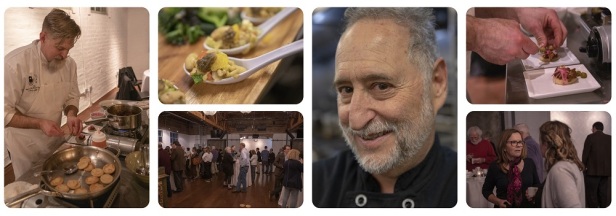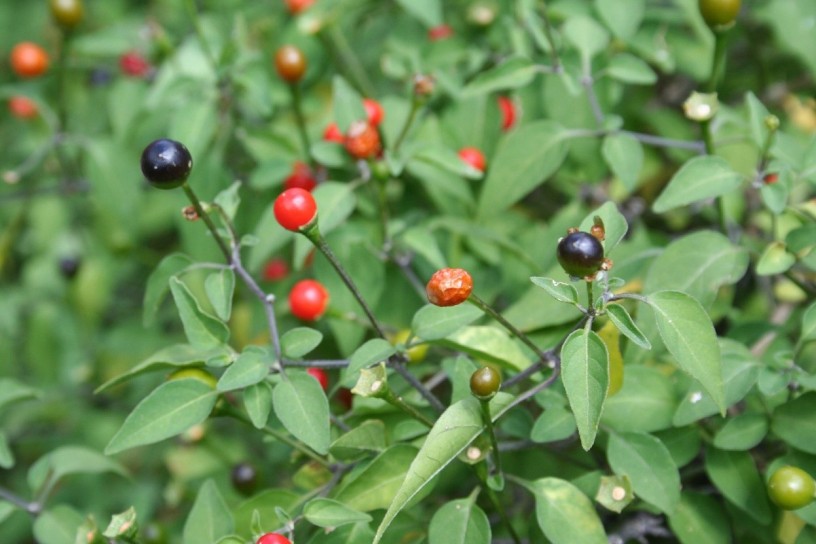
This landscape of thorny agaves, cacti, mesquite trees and rock is not the first place one might imagine searching for the future of food. How could such a hot, dry place contain some of the keys to nourishing the world?
We were in the desert, an hour south of Tucson, in southern Arizona. Giant, natural walls of stone rose hundreds of feet above our heads to form a big horseshoe-shaped canyon appropriately named Rock Corral. The heat here can be punishing, and rain is scarce, and that was precisely the point. For the area is home to precious wild plants tolerant of such stresses, hiding in crevices and under scraggly trees providing just enough shelter for their survival.
This is one of a handful of places in the US where wild chile peppers grow. They’re the ancestors of the planet’s most important condiment, the spice that provides nutrients, flavor, and pain-induced endorphins to cultures worldwide. This “wild relative” – known around here as chiltepin (Capsicum annuum var. glabriusculum) – occurs from right here in Arizona, all the way south to Brazil. We notice prehistoric potsherds and grindstones at our feet. Archeological and linguistic evidence suggests human use of species as far back as 6000 years ago, in what is now Oaxaca and Puebla, Mexico, where the plant was probably domesticated.
The hodgepodge of land managers, agricultural scientists, conservationists, and educators visiting the canyon with us wanted to see the wild relative growing in its natural habitat. We headed downhill to one of the main washes that drains the area. There, on alluvial shelves, hidden under thorny trees, we found the wild chiles. Compared to their domesticated kin, the plants were small and scruffy, especially at this time of year. They had just a few leaves and pea-sized fruits, awaiting the return of the rains to start growing again.

These wild chiles remain important to local people, some of whose families have made foraging trips into this canyon to pick peppers for centuries. They are prized in these desert borderlands for their flavor, but more than anything for their heat. Families often keep a small mortar and pestle on the dinner table to grind a bit of fresh chiltepin to season their meals. On the other side of the border, in Sonora, Mexico, foragers make a living collecting, sun-drying, and selling over 50 tons of the peppers a year. They sell for as much as $100 a pound.
While the plant is important in the region, what of its contribution to the future of food around the world?
The answer is resilience. The plants that call this canyon home – which also include the cousins of sweetpotatoes, cotton, grapes, and 50 other wild relatives – need nothing from humans to survive. They have to grow when there is enough water and get by when there isn’t: Leaves angled to catch just enough sunlight without losing too much moisture; night-blooming flowers that attract the bats, birds, and moths that are active during the cooler hours; seeds perfectly timed to sprout with the rains, and flower and fruit by the time it gets dry.
These are signs of resilience that have mostly disappeared from our food crops, which often need lots of water and nutrients, as well as protection from the elements, pests, and diseases. Re-introducing these traits into our food crops via plant breeding represents a donation of much-needed “wildness” by crop relatives to their domesticated kin. But it only works if the wild species are still around to be able to offer their gifts.
The chiltepins and other crop wild relatives in the canyon are the fortunate ones. Their habitat has been actively protected for the last 20 years, thanks to the work of conservation groups like Native Seeds/SEARCH, the Arizona-Sonora Desert Museum and the University of Arizona Southwest Center, working together with the US Forest Service. These collaborations helped establish the 2,300-acre Wild Chile Botanical Area in the Colorado National Forest.
Unfortunately, most other crop wild relatives are threatened by habitat loss due to urbanization, agricultural expansion, mining, and other land use changes, or by invasive species, pollution, over-harvesting, and climate change itself. They need protection in their natural habitats, so they continue to evolve alongside the changing climate, pests, and diseases. To be safeguarded and also accessible for crop breeding, they likewise need to be collected and conserved in seed banks, botanic gardens, and other facilities where they will be available for research and education. The United Nations recognizes the importance of conserving crop wild relatives in Target 2.5 of its goal of Zero Hunger.

At the University of Arizona’s Desert Laboratory, a 115-year-old research institute on Tumamoc Hill – an 860-acre reserve on the edge of downtown Tucson – our group was introduced to desert ecologist and Laboratory Director, Ben Wilder. He told us that the facility was established long ago to understand how native local plants survive – or even thrive – in such a tough environment.
What was perhaps not as well recognized back then was how much of the native flora provided critical sustenance to people, nor how diverse and interesting were the local wild relatives of humanity’s food crops. Recent studies are showing that Arizona is among the US states with the richest range of these culturally and economically valuable wild plants. Native species from dozens of plant genera have already been used to improve the resilience of crops to climatic stresses, enhance resistance to pests and diseases, improve nutritional quality, and offer hardier rootstock for fruit, nut, and berry crops. Moreover, dozens of native wild plants continue to provide nutrition and cultural value directly to locals. In total, over 1,000 of such species occur in Arizona, with half of these being close relatives of crops, or valuable food sources in their own right. Of these, around 150 are ancestors or close cousins of globally important crops.
With all this in mind, our diverse group had come together to hash out plans to work better together between the seed banks and botanic gardens, wild lands managers and academics, conservation organizations and educators, to ensure the survival and continued availability of these desert plants. The good news was that more than half of the crop wild relative species found in two nearby reserves – Rock Corral and Walnut Gulch – are already safeguarded in Arizona’s seed banks, nurseries and botanical garden collections.
The bad news was that much work remains to be done to ensure that other important crop wild relatives and edible desert plants are conserved.

Talking about a food revolution without food at the table isn’t how things are done in the desert borderlands. And so, James Beard award-winning chef Janos Wilder of Tucson’s Downtown Kitchen, who is also Ben’s dad, gave us a chance to sample a number of different dishes featuring wild plants and desert-adapted crops native to the region and other parts of North America – including a range of wild relatives. These included a tepary bean spread with zaatar (a blend of locally harvested wild thyme, sumac, and sesame seeds), cholla (cactus) flower buds in a cold bean salad, wild tomatillos, wild oregano, and wildrice. And, of course, the chiltepin. There was also a range of beverages fermented from wild sotol and agaves. It wasn’t difficult to convince the crowd that these wild plants were not only useful for resilience, but also tasty.
By the end of this voyage, our group had created a stronger resolve to work together to protect these scraggly plants, and to make sure they are available to contribute to a more resilient food future. The climate is likely to get even hotter and drier across most of the borderlands in the years to come. Scarce moisture will become only more precious. Local food production only more vulnerable to the heat and drought. It’s a very real possibility that the remaining water will go to domestic uses rather than agriculture, making locals even more dependent on importing food from greener states in the U.S. and from Mexico. One thing we could all agree on was that that every bit of progress we can make towards being able to grow crops adapted to hotter and drier conditions will be worth it- in terms of more stable yields and lower costs for farmers, and more overall regional food security.
Collaborative initiatives making progress over recent years are already showing that it is indeed possible to reach beyond institutional silos to catch the wild plants falling between the cracks in organizational mandates. With the burn of fresh chile still on their lips, the group identified five priority areas for partnerships:
1) to further understand and document our crop wild relatives and wild utilized plants, assess threats to their natural habitats, and determine gaps in their conservation.
2) to better protect important and threatened species in their natural habitats,
3) to collect and conserve the diversity of prioritized species in public genebanks, botanic gardens, and other conservation repositories
4) to make this diversity more accessible and attractive for plant breeding, research, and education, and
5) to raise public awareness of their value and the threats to their persistence.
We invite you to join us in our collaborative efforts to protect, make use of, and raise awareness about crop wild relatives and other wild utilized plants. For more information:
Khoury CK, Greene SL, Moreau T, Krishnan S, and Miller AJ (2019) A Road Map for Conservation, Use, and Public Engagement around Crop Wild Relatives and Wild Utilized Plants of North America. Crop Science 59(6): 2302-2307. doi: 10.2135/cropsci2019.05.0309.
Khoury CK and Nabhan GP (2019) Conservation and Use of Crop Wild Relatives in Arizona. Southwest Center, University of Arizona, Tucson, Arizona.
Khoury CK, Nabhan GP (2019) “How Fiery Desert Chilis Can Protect Us from Climate Change” Food Tank, 25 June 2019.
Khoury CK, Nabhan GP, Joy S, Gayeton D (2019) “Getting to know Teparies, Chiles, and their wilder cousins”. Lexicon of Sustainability, 14 June 2019.
Desert Laboratory on Tumamoc Hill – University of Arizona
University of Arizona Southwest Center
University of Arizona Center for Regional Food Studies
USDA Forest Service – Chiltepine or Bird Pepper (Capsicum annuum var. glabriusculum).
